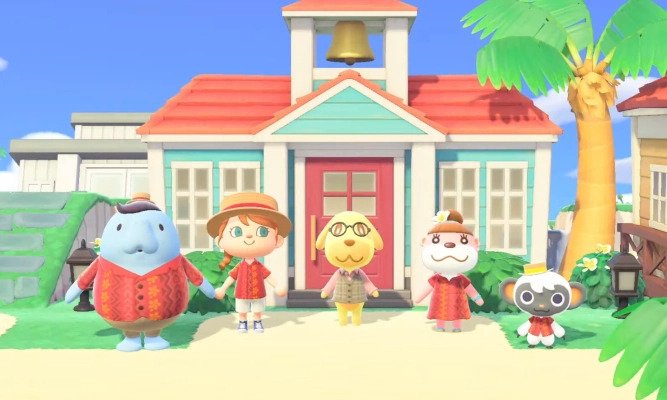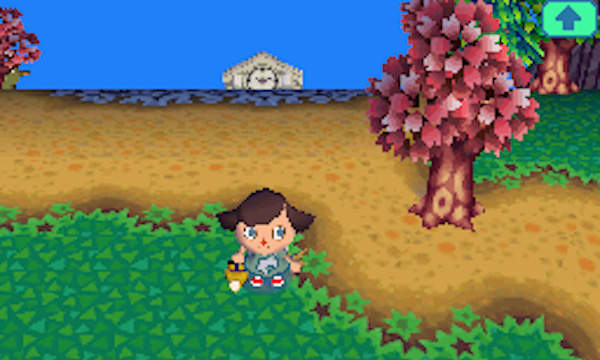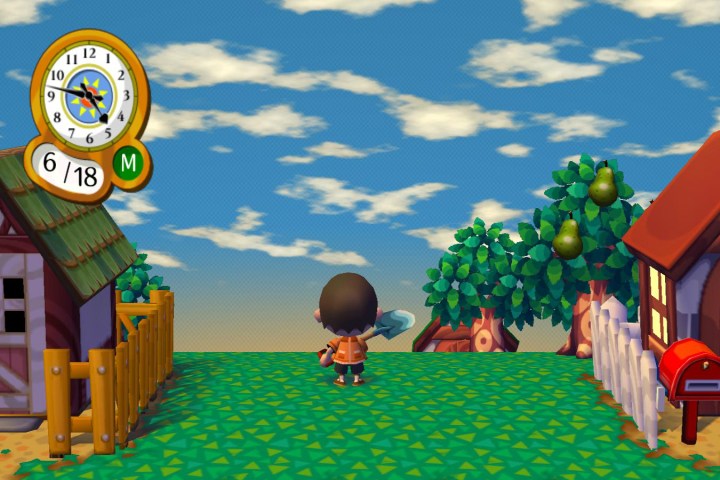The Animal Crossing games have always had a dedicated fanbase. It wasn’t until Animal Crossing: New Horizons arrived on the Nintendo Switch, however, that the series exploded in popularity. This cute life-simulation series speaks to the more laid-back crowd, somewhere between a game like the Sims and a Harvest Moon-style game. While each game does mix things up, adding new mechanics and ways to express yourself and explore, the core concept has always been about taking your time, making friends, and living out a peaceful life in these bright and colorful worlds. Oh, and paying off the massive debt you always seem to get dumped on you by Tom Nook, of course.
Animal Crossing began on the N64 in Japan, but the first time we got to experience this lovely series was on the GameCube in 2001. Including the debut entry, only eight titles in the series have been made across various systems. While this is a small number compared to some other Nintendo franchises, such as Zelda or Mario, each game can be played almost endlessly. The number of things to do, make, decorate, and more makes it hard not to get hooked on these games. Whether you’re a seasoned villager or looking for a new game to relax with, we’ve taken all of the Animal Crossing games and ranked them from best to worst.
See more
- Animal Crossing: New Horizons beginner’s guide
- The best Kirby games, ranked from best to worst
- The best Mario games of all time
1. Animal Crossing: New Horizons

Now that the honeymoon period is over and we can look back at the entire series with as objective an eye as we can, we still have to give the top spot to Animal Crossing: New Horizons. Based on the sales numbers, this is probably not too controversial an opinion, but that doesn’t mean it was far and away the best. What pushes Animal Crossing: New Horizons to the top of the series is a bunch of quality-of-life improvements, new mechanics, and new ways to customize your village (or island in this case), all while keeping that magical charm the series captures so well. While not everything worked as smoothly, or was even included, when the game came out, playing it now feels almost like an entire second game was added.
Animal Crossing: New Horizons shakes things up by making you the owner of your own island. There’s a huge cast of new villagers that can join you, rotating bugs and fish to collect, new items to craft, fruit to harvest, and so much more. The game is expertly designed to always give you something to strive toward, as well as smaller tasks to keep you wanting to come back every day. Visiting new islands for materials you can’t find on your own island, or taking a trip over to a friend’s island to see how they’ve decorated their world, are all fantastic ways to make this game feel like the most social version of this series yet. If you enjoy customizing every aspect of your world, Animal Crossing: New Horizons will keep you engaged for months on end.
2. Animal Crossing: New Leaf

Before the Switch was even a far-off dream, Animal Crossing: New Leaf fulfilled our desires for an Animal Crossing experience on the go. Released for the 3DS, this was just the fourth game Nintendo put out in the series, and their first one on a handheld, yet it nailed everything fans wanted from this experience. The weaker power of the 3DS made no difference here. The art style translated perfectly, and because there’s no action or reflex-intensive moments, performance was not a problem at all. Coming off of one of the less impressive games in the series, Animal Crossing: New Leaf brought in a host of mechanics that set the foundation for Animal Crossing: New Horizons to build upon.
Unlike earlier entries, Animal Crossing: New Leaf actually places you in the role of the mayor of your village rather than just a resident. This makes much more sense considering how much power you always had, but they also used that to introduce a whole host of new mechanics. You can now pass laws and do public work projects to build new shops and infrastructure, all toward improving your town status. It isn’t all just paperwork, though. This is where new activities like swimming and visiting other islands, again something Animal Crossing: New Horizons would take notes from, were first introduced. It even has some light multiplayer modes where you can play others in some minigames to unlock unique items for your town.
3. Animal Crossing

The first and original Animal Crossing knew exactly what it wanted to be right from the start. The art style was perfect for the system and even today looks great. Most of all, though, people loved it for just how different it was from anything else on the market. Unlike a Harvest Moon, Animal Crossing didn’t pin you down to be a farmer. Instead, you were basically free to dabble in as many different activities as you wanted. While it wasn’t the cultural phenomenon that Animal Crossing: New Horizons would be, this game did really start the trend of Nintendo games appealing to a wider audience who didn’t typically play many games.
Sure, Animal Crossing is light on features compared with the later games. Still, what’s there is what the series would make its name on. There are plenty of villagers you can speak to, make friends with, and interact with in ways that many games today still don’t match. It also felt incredibly advanced and almost unreal at the time by using the internal clock of the GameCube to track the time of day, but also trigger different seasonal events. Coming into your town to find it covered in snow, or set up for a Cherry Blossom Festival, without any warning made Animal Crossing feel like it was a truly real and living place. They even had a bunch of old NES games you could unlock and play within the game.
4. Animal Crossing: Wild World

The first sequel to the original Animal Crossing does take a step back from the original, but it has the portability factor going for it. Released for the original DS, Animal Crossing: Wild World just wasn’t able to cram as much content onto the handheld as many would have liked compared to what we had experienced on the GameCube. Still, this entry made it clear that taking your village with you was how this series was meant to be played. The smaller scale perhaps even made the idea of checking in on your village on to the go more manageable, even if more hardcore players felt a little light on things to do.
Animal Crossing: Wild World took advantage of another aspect of the DS and experimented with online play. The original game only let you visit other people’s villages if you physically brought over your memory cards, but now the DS allowed you to check out your friend’s town remotely. This game did feel like a trimmed-down version of the first game, only portable and with some new ways to interact and socialize with your NPC villagers. The touch screen was also a much cleaner way to manage your inventory, as well as a fun way to design your own cosmetics.
5. Animal Crossing: City Folk

Animal Crossing: City Folk was an odd entry. It hit the Wii in 2008, just three years after Animal Crossing: Wild World. Because the series was back on a main home console, fans were ready for the next major leap in the series. If Animal Crossing: City Folk was going to ditch the portability, it should at least be a bigger game than the first, right? Well, in some ways it was, but not in the way fans really wanted. Aside from some technical additions, nothing about this game made it feel like a necessary entry in the series. It looked fine enough on the Wii, but not all that distinguishable from the original, and the Wii controls weren’t utilized for anything interesting. For some reason, the maximum number of villagers was also less than the original at a maximum of 10 compared to 15.
You already know the basics of what you can do in Animal Crossing: City Folk. There’s fishing, bug collecting, gardening, and fossil hunting. The one really new thing this entry brings to the table is the city area, as the title implies. However, your village is completely separate from this City Plaza area. To reach it you need to take a bus, thus go through a loading screen, where you can visit some different shops, including an online Auction House, and see a few unique NPCs. Since you also have Tom Nook and the Able Sisters’ stores within your village, you quickly run out of reasons to endure the long load to go to the city at all, which again was this game’s primary new feature. Unless you haven’t played another Animal Crossing game before it, there’s little reason to give Animal Crossing: City Folk your time, especially with the online service shut down.
6. Animal Crossing: Happy Home Designer

One of the main allures of the Animal Crossing games is that they don’t try and pin you down to just one thing. They’re wide open, lite life simulators. Animal Crossing: Happy Home Designer breaks that appeal by taking away most of that freedom and giving you the job of designer. Sure, designing your home was plenty of people’s favorite parts of the other games, but that wasn’t the only thing you could do. While it is technically a spin-off game, you wouldn’t be able to tell based on the title. When you factor in how many people who don’t follow games all that closely play this series, plenty of people came into this game expecting a full Animal Crossing experience only to be let down.
Rather than having your own home to customize, Animal Crossing: Happy Home Designer gives you the responsibility of being the architect of an entire village. That means every building, including other villagers’ houses, office buildings, schools, and more, are yours to plan and design, both inside and out. That might sound like a nice addition to the formula if it were in fact an addition rather than the entire experience. You have an incredibly robust toolset for designing and decorating all these buildings, but … that’s all you can really do. There’s basically no more life sim elements, or even anything to push you to keep playing. Your objectives are just … designing houses. Sometimes villagers will have requests you need to meet, like including a color or specific piece of furniture, but that’s about it. Unless you only play Animal Crossing for the home design aspect, this is an easy one to skip.
7. Animal Crossing: Pocket Camp

As great as Animal Crossing proved to be on handheld devices, the iOS and Android attempt wasn’t quite the best move. Instead of bringing a classic Animal Crossing experience to the phone, it adopted the lesser qualities of phone games and applied them to an Animal Crossing game. Animal Crossing: Pocket Camp was never expected to be a fully featured entry, or be the next big hit, but it fell below even those low expectations when it came out. Sure, it’s free, but with so little to do, and so much pressure to spend money on it, it kind of went against the entire premise the series had set since the beginning.
Animal Crossing: Pocket Camp is not a joyful, relaxing time for most players. The idea is that you are in charge of running and building a campsite, which makes sense for a smaller-scale game. However, your options for activities are about as limited as one could expect. Aside from basic gathering and bug hunting, there’s little to actually do here. You can hang out with some villagers, but interactions are limited and will get old fast. The worst part, as alluded to earlier, is the microtransactions. Animal Crossing: Pocket Camp really shoves its monetization in your face. You won’t be able to go more than a few minutes without feeling the pressure to buy a lootbox or subscribe to the different paid services to access items and even events.
8. Animal Crossing: Amiibo Festival

There’s no other option to put at the bottom of an Animal Crossing games list than Animal Crossing: Amiibo Festival. Not only is this an Animal Crossing game in name only, but it’s just a bad game overall. The only minor saving grace, if you want to call it that, is that this game was released exclusively on the WiiU, meaning that very few Animal Crossing fans know it exists or had to suffer through playing it. Before even touching on why the actual game itself is so disappointing, we have to address the fact that this game required the use of Amiibo, or Amiibo cards, to even play. You technically just need one Animal Crossing-specific Amiibo to play, but any other character has to be unlocked with either an expensive and often hard-to-find Amiibo or extra Amiibo card. And this game isn’t even free like Animal Crossing: Pocket Camp, either. You already paid full price for this.
Make no mistake, Animal Crossing: Amiibo Festival is not an Animal Crossing game. Despite having the name and characters, this is a Mario Party ripoff, and it doesn’t even do that well. We already hit on how you can only play with new characters by purchasing Amiibo, but even if you somehow ignored all that, the game itself is just so dull. The boards are generic and slow, the mini-games are tedious at best, and worst of all is the Happy Points system. Instead of earning money, Bells, to purchase something like Stars in Mario Party, you’re all trying to earn the most Happy Points. These are given away by landing on certain spaces, as are Bells, which at the end of the game are just converted into Happy Points anyway, making them kind of useless. There are other game modes and things to unlock, but the grind required to do so is unreasonable for a game that feels more like a chore anyway.



